PNC Financial Services Bundle
How did PNC Financial Services Become a Banking Giant?
Delve into the fascinating PNC Financial Services SWOT Analysis to understand the strategic moves that propelled PNC from its humble beginnings. This journey begins in the mid-19th century, tracing the evolution of PNC Bank from a local Pittsburgh institution to a national powerhouse. Discover how mergers, acquisitions, and strategic decisions shaped PNC's remarkable growth within the competitive landscape of financial institutions.
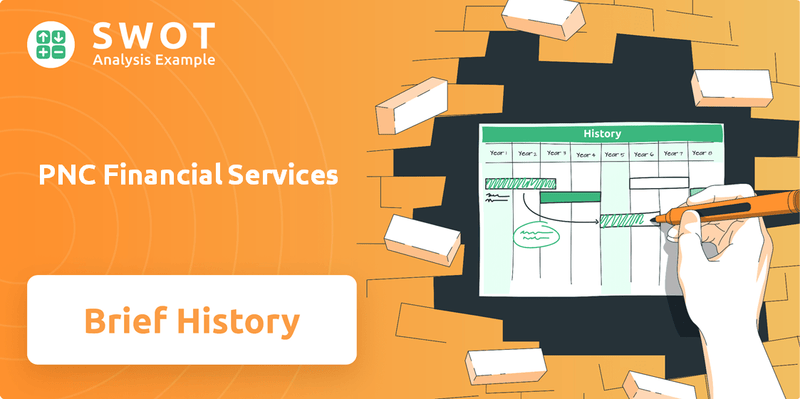
Uncover the brief history of PNC Financial Services, exploring its pivotal moments and strategic shifts. From its origins as Pittsburgh Trust and Savings Company to its current status as a leading financial institution, PNC's story is one of continuous adaptation and expansion. Learn about the key milestones, including the National City Bank PNC merger, that have defined PNC's trajectory and its impact on the financial industry. Explore PNC's geographic expansion and leadership to understand how PNC Bank has become a significant force in economic development.
What is the PNC Financial Services Founding Story?
The story of the PNC Financial Services starts in the mid-19th century with the establishment of two key institutions. Understanding the brief history of PNC Financial Services helps to appreciate its evolution into a major player in the financial industry. The roots of PNC history are deeply embedded in the growth of banking in the United States.
The PNC company's story begins on April 10, 1845, with the Pittsburgh Trust and Savings Company in Pittsburgh, Pennsylvania. Due to the challenges of the Great Fire of Pittsburgh, the bank's full operation started on January 28, 1852, at Liberty Avenue and 12th Street. By 1853, it became The Pittsburgh Trust Company. The corporate offices moved to Fifth Avenue and Wood Street in Pittsburgh by 1858, a location it still occupies.
Another crucial part of the story is the Provident Life and Trust Company, founded in Philadelphia in 1865. The merger of Pittsburgh National Corporation and Provident National Corporation in 1982 was a turning point, leading to the formation of PNC Financial Corporation. This merger was the biggest bank merger in American history at the time, with assets totaling $10.3 billion. The name 'PNC' comes from the initials of these two companies. The aim was to create a strong financial institution, combining the strengths of both regional entities to offer a wide range of financial services.
The early history of PNC Bank is marked by strategic mergers and expansions.
- 1845: Pittsburgh Trust and Savings Company founded.
- 1852: Pittsburgh Trust and Savings Company begins operations.
- 1865: Provident Life and Trust Company established.
- 1982: Pittsburgh National Corporation and Provident National Corporation merge to form PNC Financial Corporation.
- The merger with National City Bank in 2008 was significant.
PNC has grown significantly since its inception, evolving into one of the largest financial institutions in the United States. The merger with National City Bank in 2008 was a major step in its expansion, significantly increasing its presence and capabilities. The strategic decisions made throughout PNC's growth over time have shaped its current status. For more insights into how PNC operates, check out Revenue Streams & Business Model of PNC Financial Services.
PNC Financial Services SWOT Analysis
- Complete SWOT Breakdown
- Fully Customizable
- Editable in Excel & Word
- Professional Formatting
- Investor-Ready Format
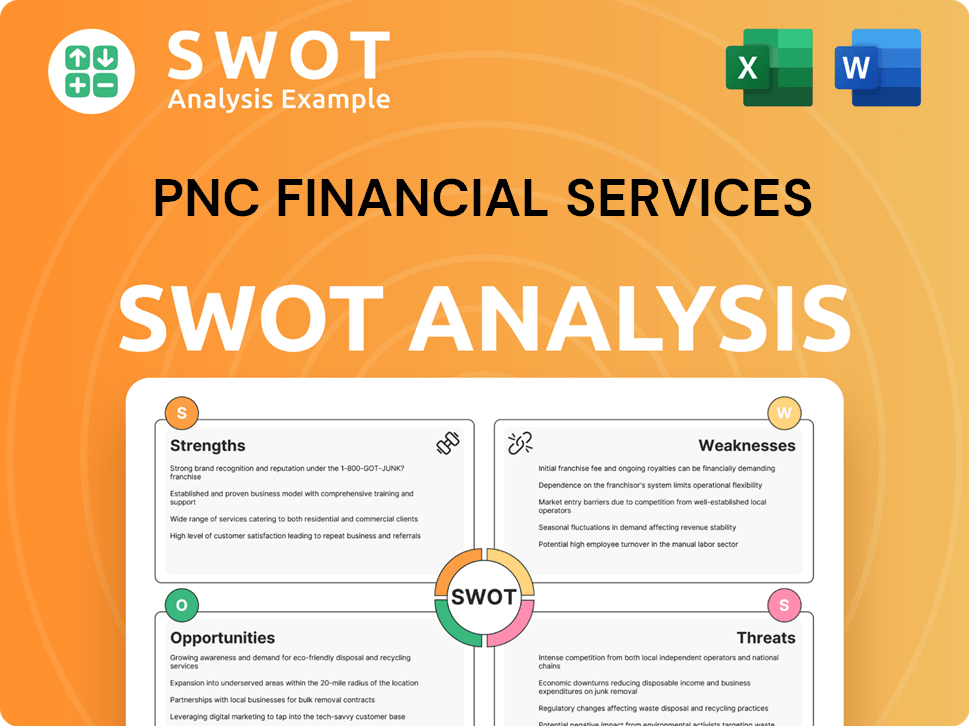
What Drove the Early Growth of PNC Financial Services?
The early growth of PNC Financial Services was marked by strategic acquisitions and expansion. Following its formation in 1983, the company quickly began acquiring other financial institutions. This aggressive approach allowed PNC history to establish a strong presence in the financial industry and significantly grow its assets.
PNC Financial Services began its acquisition strategy in 1986, just three years after its inception. This early move set the stage for a series of acquisitions throughout the 1980s and 1990s. These acquisitions were crucial for expanding PNC Bank's footprint and market share.
The 1990s saw PNC company make several significant acquisitions, including First Eastern Bank (1994) and Midlantic Corporation (1995). By the late 1990s, PNC's assets had grown substantially, reaching $75.8 billion. These acquisitions helped PNC surpass its rival, Mellon Financial, in the Pittsburgh area.
In the early 1990s, PNC also focused on consolidation to address issues inherited from acquired banks. This included managing underperforming real estate loans. This strategic shift aimed to optimize its portfolio and increase efficiency, setting the stage for future growth.
PNC's acquisition trend continued into the 21st century, with major deals like Mercantile Bankshares (2007) and Sterling Financial Corporation (2008). The acquisition of BBVA USA in 2021 for $11.6 billion significantly boosted PNC's presence across several states. For more information on the competitive landscape, you can read about the Competitors Landscape of PNC Financial Services.
PNC Financial Services PESTLE Analysis
- Covers All 6 PESTLE Categories
- No Research Needed – Save Hours of Work
- Built by Experts, Trusted by Consultants
- Instant Download, Ready to Use
- 100% Editable, Fully Customizable
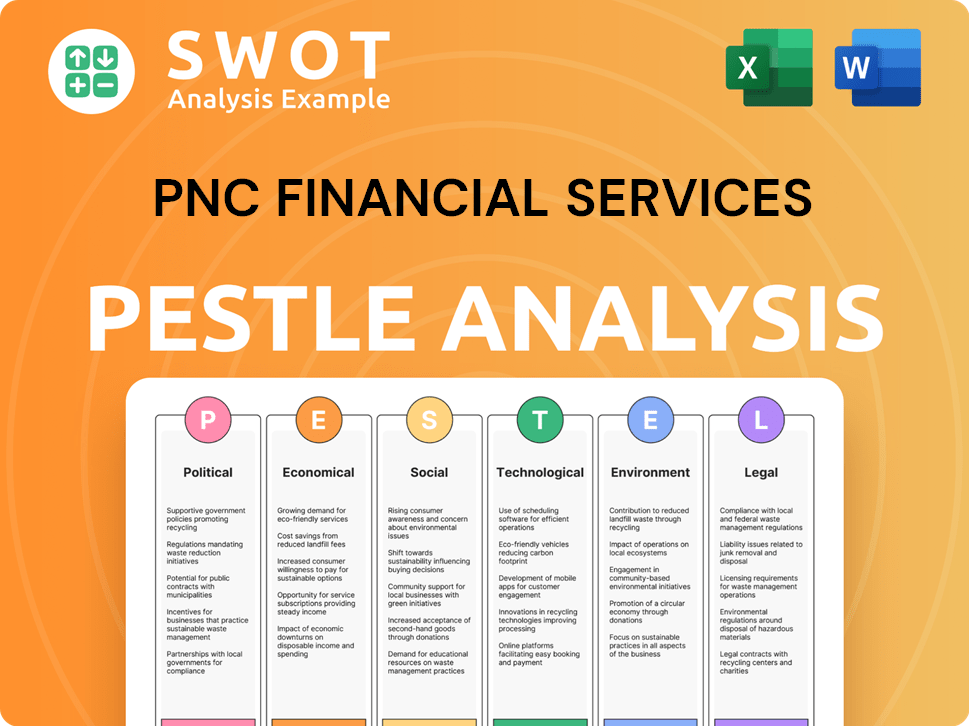
What are the key Milestones in PNC Financial Services history?
The PNC Financial Services has a rich history, marked by significant milestones that have shaped its trajectory in the financial industry. Understanding the PNC history provides insights into its evolution and its impact on the financial landscape.
| Year | Milestone |
|---|---|
| 2000 | The company adopted a new brand image and changed its name to PNC Financial Services Group. |
| 2001 | PNC sold its original PNC Mortgage to Washington Mutual due to market volatility. |
| 2008 | PNC acquired National City Bank, significantly expanding its footprint. |
| 2020 | PNC acquired BBVA USA, further solidifying its position in the market. |
| 2024 | PNC provided over $75 million in grants and sponsorships to support community programs. |
PNC Financial Services has consistently demonstrated a commitment to innovation, adapting to the changing needs of its customers and the financial market. A key innovation was the launch of Low Cash Mode®, which helps customers avoid overdraft fees.
This product is designed to help customers avoid overdraft fees through enhanced account transparency and control. This feature reflects PNC Bank's focus on customer-centric solutions.
PNC has been recognized for its commitment to corporate social responsibility, supporting initiatives in early childhood education and community development. In 2024, the company's employees volunteered over 100,000 hours in community service.
PNC continues to seek business and technological improvements to reduce operating costs and increase efficiency. The company is actively investing in cybersecurity measures to protect against threats.
Despite its successes, PNC has faced various challenges throughout its history. These challenges have included legal and regulatory issues, market downturns, and competitive pressures.
PNC has had to adapt to market downturns and competitive threats, leading to strategic pivots and repositioning efforts. The sale of PNC Mortgage in 2001 is an example of this adaptation.
In response to an increasingly competitive financial services environment, PNC continues to seek business and technological improvements to reduce operating costs and increase efficiency. This includes workforce reductions.
In late 2023, PNC implemented a workforce reduction, expected to reduce 2024 personnel expenses by approximately $325 million annually. This highlights the company's efforts to streamline operations.
PNC is actively investing in cybersecurity measures to protect against threats. This reflects the increasing importance of digital security in the financial industry.
For more insights, explore the Target Market of PNC Financial Services.
PNC Financial Services Business Model Canvas
- Complete 9-Block Business Model Canvas
- Effortlessly Communicate Your Business Strategy
- Investor-Ready BMC Format
- 100% Editable and Customizable
- Clear and Structured Layout
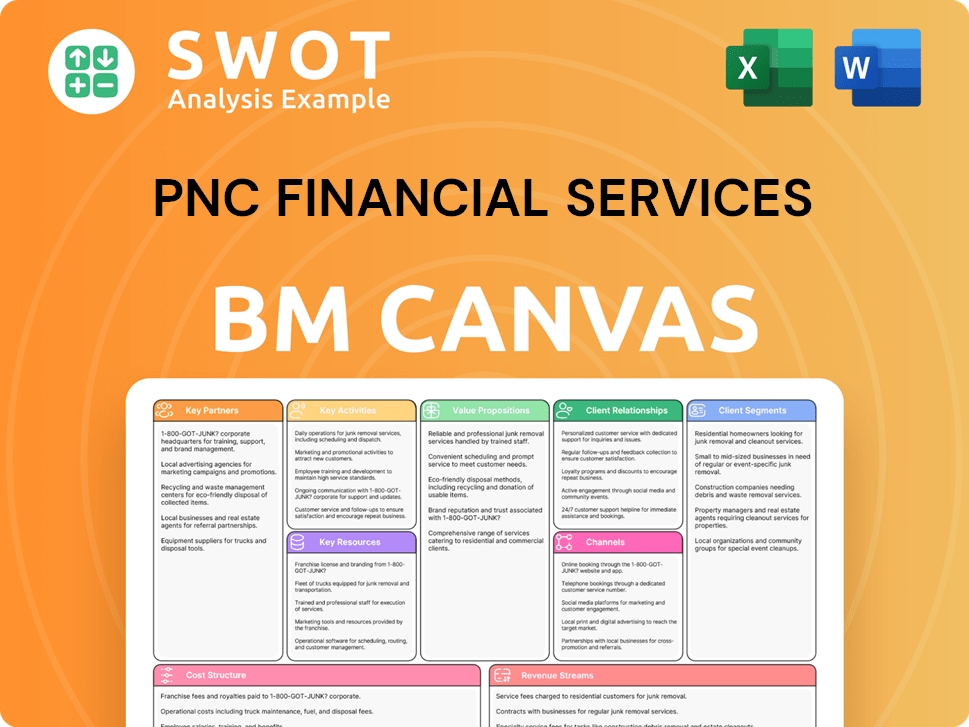
What is the Timeline of Key Events for PNC Financial Services?
The PNC Financial Services journey is marked by strategic mergers and acquisitions, and significant expansions. From its origins in Pittsburgh to its current status as a major player in the financial industry, PNC has consistently adapted to the evolving financial landscape. Key milestones include early formations, mergers, and acquisitions that expanded its market presence. The company has also focused on digital transformation and community investment.
| Year | Key Event |
|---|---|
| 1852 | Pittsburgh Trust and Savings Company is founded in Pittsburgh, Pennsylvania. |
| 1863 | The bank is renamed First National Bank of Pittsburgh and becomes the first bank in the country to apply for a national charter. |
| 1946 | First National Bank of Pittsburgh merges with Peoples-Pittsburgh Trust Company to form Peoples First National Bank & Trust. |
| 1959 | Peoples First merges with Fidelity Trust Company to form Pittsburgh National Bank. |
| 1983 | Pittsburgh National Corporation and Provident National Corporation merge to form PNC Financial Corporation. |
| 1995 | Acquisition of Midlantic Corporation, expanding PNC's market presence. |
| 2000 | The company adopts a new brand image and changes its name to PNC Financial Services Group. |
| 2008 | Acquisition of National City Corporation, significantly increasing PNC's size and market share. |
| 2012 | Acquisition of RBC Bank USA, expanding its footprint in the southeastern U.S. |
| 2015 | The bank opens Tower at PNC Plaza, its new headquarters in Pittsburgh. |
| 2020 | Sale of its stake in BlackRock. |
| 2021 | Acquisition of BBVA USA for $11.6 billion, significantly boosting its presence in the Sunbelt states. |
| 2022 | Launch of the $88 billion Community Benefits Plan, set to conclude in 2025. |
| 2024 | PNC announces plans to invest approximately $1 billion to enhance its branch network, opening over 100 new locations and renovating more than 1,200 existing branches. |
PNC anticipates stable average loans, with spot loans increasing by 2% to 3% in 2025. Net interest income is projected to rise by 6% to 7%, and noninterest income by approximately 5%. These forecasts indicate continued financial growth and stability for the company.
By May 2025, PNC had deployed nearly $85.5 billion, representing 97% of its Community Benefits Plan pledge. The plan, valued at $88 billion, is set to conclude in 2025, aiming to maximize its impact on communities. This demonstrates PNC's commitment to community investment.
Analysts generally maintain a 'Hold' rating for PNC stock, with an average price target of $221.65. They expect EPS to improve by 10.5% to $15.37 for the current fiscal year. This indicates a cautiously optimistic outlook for PNC's financial performance.
PNC is focused on expanding into new markets and digital platforms, deepening customer relationships, and leveraging technology. Strategic initiatives like digital transformation and market expansion are expected to be key drivers of future success. These efforts will help PNC remain competitive in the financial industry.
PNC Financial Services Porter's Five Forces Analysis
- Covers All 5 Competitive Forces in Detail
- Structured for Consultants, Students, and Founders
- 100% Editable in Microsoft Word & Excel
- Instant Digital Download – Use Immediately
- Compatible with Mac & PC – Fully Unlocked
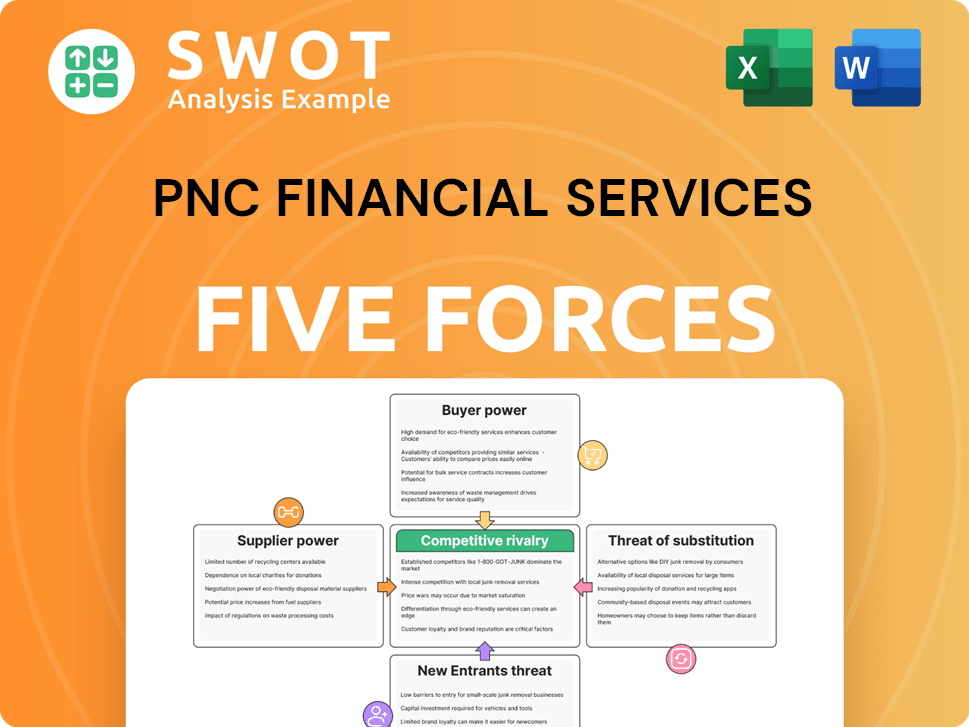
Related Blogs
- What is Competitive Landscape of PNC Financial Services Company?
- What is Growth Strategy and Future Prospects of PNC Financial Services Company?
- How Does PNC Financial Services Company Work?
- What is Sales and Marketing Strategy of PNC Financial Services Company?
- What is Brief History of PNC Financial Services Company?
- Who Owns PNC Financial Services Company?
- What is Customer Demographics and Target Market of PNC Financial Services Company?
Disclaimer
All information, articles, and product details provided on this website are for general informational and educational purposes only. We do not claim any ownership over, nor do we intend to infringe upon, any trademarks, copyrights, logos, brand names, or other intellectual property mentioned or depicted on this site. Such intellectual property remains the property of its respective owners, and any references here are made solely for identification or informational purposes, without implying any affiliation, endorsement, or partnership.
We make no representations or warranties, express or implied, regarding the accuracy, completeness, or suitability of any content or products presented. Nothing on this website should be construed as legal, tax, investment, financial, medical, or other professional advice. In addition, no part of this site—including articles or product references—constitutes a solicitation, recommendation, endorsement, advertisement, or offer to buy or sell any securities, franchises, or other financial instruments, particularly in jurisdictions where such activity would be unlawful.
All content is of a general nature and may not address the specific circumstances of any individual or entity. It is not a substitute for professional advice or services. Any actions you take based on the information provided here are strictly at your own risk. You accept full responsibility for any decisions or outcomes arising from your use of this website and agree to release us from any liability in connection with your use of, or reliance upon, the content or products found herein.